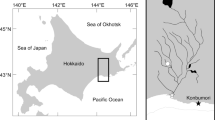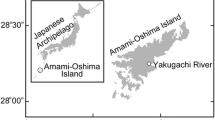Abstract
Juvenile chum salmon Oncorhynchus keta originating from rivers along the Pacific coast of Japan migrate northwards to the Sea of Okhotsk, typically passing off Konbumori, near the easternmost part of Hokkaido Island. We used daily-increment analysis of otoliths to back-calculate the growth rates [mean daily growth rate in fork length (FL)] of 369 juveniles (56–146 mm FL) originating from various rivers southwest of Konbumori, and sampled at Konbumori between 2005 and 2014. We examined differences in growth rate in terms of differences in distance from the source of juveniles, their river or region of origin, to Konbumori, and FL at time of collection. The results show that juvenile chum salmon originating from distant sources tended to grow faster than those from more proximal sources, likely contributing to larger FLs in the former. Growth rates of larger fish (≥ 90 mm FL) differed little (medians: 0.64–0.68 mm/day) among regions of origin, whereas those of smaller fish tended to be low among fish originating from more proximal regions (20–126 km from Konbumori). These results suggest that fish migrating from more distant rivers were better able to survive and to reach Konbumori by achieving or exceeding a certain growth rate.






Similar content being viewed by others
Change history
25 June 2018
In the original publication of the article the equation appeared.
28 January 2024
A Correction to this paper has been published: https://doi.org/10.1007/s12562-023-01747-w
References
Morita K, Saito T, Miyakoshi Y, Fukuwaka MA, Nagasawa T, Kaeriyama M (2006) A review of Pacific salmon hatchery programmes on Hokkaido Island, Japan. ICES J Mar Sci 63:1353–1363
Kitada S (2014) Japanese chum salmon stock enhancement: current perspective and future challenges. Fish Sci 80:237–249
Miyakoshi Y, Urabe H, Saneyoshi H, Aoyama T, Sakamoto H, Ando D, Kasugai K, Mishima Y, Takada M, Nagata M (2012) The occurrence and run timing of naturally spawning chum salmon in northern Japan. Environ Biol Fishes 94:197–206
Morita K, Takahashi S, Ohkuma K, Nagasawa T (2013) Estimation of the proportion of wild chum salmon Oncorhynchus keta in Japanese hatchery rivers. Nippon Suisan Gakkaishi 79:206–213 (in Japanese with English abstract)
Morita K (2014) Japanese wild salmon research: toward a reconciliation between hatchery and wild salmon management. N Pac Anadr Fish Comm Newsl 35:4–14
Healey MC (1982) Timing and relative intensity of size-selective mortality of juvenile chum salmon (Oncorhynchus keta) during early sea life. Can J Fish Aquat Sci 39:952–957
Bax NJ (1983) Early marine mortality of marked juvenile chum salmon (Oncorhynchus keta) released into Hood Canal, Puget Sound, Washington, in 1980. Can J Fish Aquat Sci 40:426–435
Beamish RJ, Nevile CM (2001) Predation-based mortality on juvenile salmon in the Strait of Georgia. N Pac Anadr Fish Comm Tech Rep 2:11–13
Tucker S, Hipfner JM, Trudel M (2016) Size- and condition-dependent predation: a seabird disproportionately targets substandard individual juvenile salmon. Ecology 97:461–471
Beamish RJ, Mahnken Neville CM (2004) Evidence that reduced early marine growth is associated with lower marine survival of coho salmon. Trans Am Fish Soc 133:26–33
Moss JH, Beauchamp DA, Cross AD, Myers KW, Farley EV, Murphy JM, Helle JH (2005) Evidence for size-selective mortality after the first summer of ocean growth by pink salmon. Trans Am Fish Soc 134:1313–1322
Duffy EJ, Beauchamp DA (2011) Rapid growth in the early marine period improves the marine survival of Chinook salmon (Oncorhynchus tshawytscha) in Puget Sound, Washington. Can J Fish Aquat Sci 68:232–240
Woodson LE, Wells BK, Weber PK, Macfarlane RB, Whitman GE, Johnson RC (2013) Size, growth, and origin-dependent mortality of juvenile Chinook salmon Oncorhynchus tshawytscha during early ocean residence. Mar Ecol Prog Ser 487:163–175
Brothers EB (1990) Otolith marking. Am Fish Soc Symp 7:183–202
Volk EC, Schroder SL, Fresh KL (1990) Inducement of unique otolith banding patterns as a practical means to mass-mark juvenile Pacific salmon. Am Fish Soc Symp 7:203–215
Munk K, Smoker W, Beard D, Mattson R (1993) A hatchery water-heating system and its application to 100% thermal marking of incubating salmon. Prog Fish Cult 55:284–288
Urawa S, Hagen P, Meerburg D, Rogatnykh A, Volk E (2001) Compiling and coordinating salmon otolith marks in the North Pacific. N Pac Anadr Fish Comm Tech Rep 3:13–15
Urawa S, Sato S, Crane PA, Agler B, Josephson R, Azumaya T (2009) Stock-specific ocean distribution and migration of chum salmon in the Bering Sea and north Pacific Ocean. N Pac Anadr Fish Comm Bull 5:131–146
Hasegawa K, Sato T, Sasaki K (2013) Distinguishing local growth from immigration-based size shifts for juvenile chum salmon communities in coastal Hokkaido, northern Japan. Fish Sci 79:611–616
Kasugai K, Saneyoshi H, Aoyama T, Shinriki Y, Iijima A, Miyakoshi Y (2016) Early marine migration of juvenile chum salmon along the Pacific coast of eastern Hokkaido. N Pac Anadr Fish Comm Bull 6:61–72
Shubin AO, Akinicheva EG (2016) Origin of juvenile chum salmon Oncorhynchus keta (Salmonidae) in the Sea of Okhotsk coastal waters off South Sakhalin. J Ichthyol 56:728–737
Saito T, Shimizu I, Seki J, Nagasawa K (2009) Relationship between zooplankton abundance and the early marine life history of juvenile chum salmon Oncorhynchus keta in eastern Hokkaido, Japan. Fish Sci 75:303–316
Freshwater C, Trudel M, Beacham TD, Neville CE, Tucker S, Juanes F (2015) Validation of daily increments and a marine-entry check in the otoliths of sockeye salmon Oncorhynchus nerka post-smolts. J Fish Biol 87:169–178
Vega SC, Sutton TM, Murphy JM (2017) Marine-entry timing and growth rates of juvenile chum Salmon in Alaskan waters of the Chukchi and northern Bering seas. Deep Sea Res Part II 135:137–144
Kaeriyama M (1986) Ecological study on early life of the chum salmon, Oncorhynchus keta (Walbaum). Sci Rep Hokkaido Salmon Hatchery 40:31–92 (in Japanese with English abstract)
Irie T (1990) Ecological studies on the migration of juvenile chum salmon, Oncorhynchus keta, during early ocean life. Bull Seikai Natl Fish Res Inst 68:1–142 (in Japanese with English abstract)
Mayama H, Ishida Y (2003) Japanese Studies on the Early Ocean Life of Juvenile Salmon. N Pac Anadr Fish Comm Bull 3:14–67
Urawa S (2015) Ocean distribution and migration of Japanese chum salmon. Bull Fish Res Agen 39:9–19 (in Japanese with English abstract)
Volk EC, Wissmar RC, Simenstad CA, Eggers DM (1984) Relationship between otolith microstructure and the growth of juvenile chum salmon (Oncorhynchus keta) under different prey rations. Can J Fish Aquat Sci 41:126–133
Neilson JD, Geen GH, Bottom D (1985) Estuarine growth of juvenile chinook salmon (Oncorhynchus tshawytscha) as inferred from otolith microstructure. Can J Fish Aquat Sci 42:899–908
Zhang Z, Beamish RJ (2000) Use of otolith microstructure to study life history of juvenile chinook salmon in the Strait of Georgia in 1995 and 1996. Fish Res 46:239–250
Saito T, Kaga T, Seki J, Otake T (2007) Otolith microstructure of chum salmon Oncorhynchus keta: formation of sea entry check and daily deposition of otolith increments in seawater conditions. Fish Sci 73:27–37
Salo EO (1991) Life history of chum salmon (Oncorhynchus keta). In: Groot C, Margolis L (eds) Pacific salmon life histories. UBC Press, Vancouver, pp 233–309
Sakurai Y (2007) An overview of the Oyashio ecosystem. Deep Sea Res Part II 54:2526–2542
Wagawa T, Tamate T, Kuroda H, Ito SI, Kakehi S, Yamanome T, Kodama T (2016) Relationship between coastal water properties and adult return of chum salmon (Oncorhynchus keta) along the Sanriku coast, Japan. Fish Oceanogr 25:598–609
Saito T, Watanabe K, Sasaki K, Takahashi F (2013) The dispersal pattern of juvenile chum salmon in the Pacific Ocean off the coast of Hokkaido, Japan. N Pac Anadr Fish Comm Tech Rep 9:21–22
Seki J (2013) Development of hatchery techniques for releasing Juvenile Chum salmon in Japan. J Fish Tech 6:69–82 (in Japanese with English abstract)
Saito T, Shimizu I, Seki J, Kaga T, Hasegawa E, Saito H, Nagasawa K (2010) Can research on the early marine life stage of juvenile chum salmon Oncorhynchus keta forecast returns of adult salmon? A case study from eastern Hokkaido, Japan. Fish Sci 76:909–920
Saito T, Kaga T, Hasegawa E, Nagasawa K (2011) Effects of juvenile size at release and early marine growth on adult return rates for Hokkaido chum salmon (Oncorhynchus keta) in relation to sea surface temperature. Fish Oceanogr 20:278–293
Urawa S, Sato S, Varnavskaya N, Crane PA, Beacham TD (2007) Genetic stock identification of juvenile chum salmon caught in the Okhotsk Sea during the fall of 2003. N Pac Anadr Fish Comm Tech Rep 7:72–74
Acknowledgments
We thank staff members involved over the successive years of the study at the Japan Fisheries Research and Education Agency for their cooperation in collecting field data. We also thank T. Otake, T. Kitagawa, and K. Shirai at the University of Tokyo for their support and help with the analysis using the electron probe micro-analyzer. This study was supported by the Fisheries Agency of Japan, as part of the Salmon Resources along the Pacific Coast of Japan Restoration Project.
Author information
Authors and Affiliations
Corresponding author
Additional information
The original online version of this article was revised to add a note in table 1.
Electronic supplementary material
Below is the link to the electronic supplementary material.
Rights and permissions
About this article
Cite this article
Honda, K., Kawakami, T., Suzuki, K. et al. Growth rate characteristics of juvenile chum salmon Oncorhynchus keta originating from the Pacific coast of Japan and reaching Konbumori, eastern Hokkaido. Fish Sci 83, 987–996 (2017). https://doi.org/10.1007/s12562-017-1137-6
Received:
Accepted:
Published:
Issue Date:
DOI: https://doi.org/10.1007/s12562-017-1137-6




